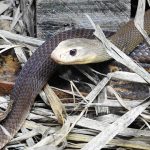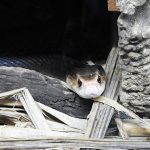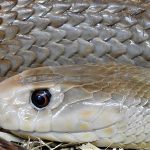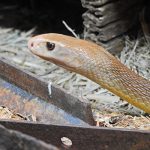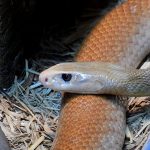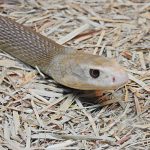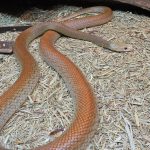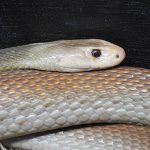COASTAL TAIPAN
The Coastal Taipan: Master of the Coastal Wilds
The Coastal Taipan, sometimes called the Eastern Taipan, is one of Australia’s most remarkable and enigmatic reptiles. This species commands both fascination and respect, not only for its formidable venom but also for its unique role within Australia’s coastal ecosystems.
Appearance and Physical Traits
Imagine walking through the tranquil sunshine of a northern Queensland woodland. Out of the corner of your eye, you spot a slender, agile shadow slipping through the undergrowth—a Coastal Taipan. This snake is notable for:
- Length: Ranging from 1.8 to 2.5 metres, making it one of Australia’s longest venomous snakes.
- Build: Slender, with a relatively short, rounded head set apart from its graceful body.
- Colouration: Its scales shimmer in hues that vary from light brown to deep chocolate, sometimes tinged with olive. The underbelly is distinctly lighter, often creamy or pale yellow.
- Sheen: In sunlight, their scales can appear almost iridescent, catching hints of gold and bronze.
Habitat and Distribution
The wild tapestry of Australia’s eastern and northern coasts is home to the Coastal Taipan. This adaptable species can be found in:
| Habitat Type | Description |
|---|---|
| Rainforests | Moist, lush environments with dense vegetation |
| Open Woodlands | Scattered trees, grassy understorey |
| Coastal Scrublands | Low, salt-tolerant shrubs near beaches |
| Grasslands | Wide open spaces, often near watercourses |
- Range: From north-eastern Queensland, tracing the eastern coastline, and extending into the Top End of the Northern Territory.
- Absence: Not found in southern Australia or the arid heart of the continent.
Behaviour and Hunting
The Coastal Taipan is a creature of the daylight, moving with astonishing speed over the forest floor. Here’s what makes its behaviour truly captivating:
- Diurnal Activity: Most active during the day, especially early morning and late afternoon.
- Speed and Agility: Among the fastest-moving snakes on Earth, able to swiftly pursue prey or evade threats.
- Defence: When startled, it may rear into an S-shaped posture, hiss, and strike rapidly, making a clear statement to any would-be threat.
- Senses: Possesses keen eyesight and a highly developed sense of smell, allowing it to detect the faintest scent trails left by prey.
Diet and Ecological Role
This snake plays a vital part in controlling populations of small mammals:
- Primary Diet: Rodents, especially rats and mice, form the bulk of its diet.
- Hunting Method: Tracks prey using scent and sight, then delivers a swift, precise strike, injecting venom that quickly immobilises.
- Ecological Importance: By preying on rodents, the Coastal Taipan helps maintain a balanced ecosystem, indirectly supporting the health of plant communities and other wildlife.
Venom: Nature’s Potent Cocktail
The Coastal Taipan’s venom is among the world’s most powerful:
- Composition: A blend of neurotoxins (affecting the nervous system), procoagulants (disrupting blood clotting), and myotoxins (damaging muscle tissue).
- Effects: In prey, causes rapid paralysis and death. In humans, a bite is a medical emergency, but effective antivenom and swift treatment have drastically reduced fatalities in recent decades.
- Scent and Sound: When threatened, the Taipan may emit a musky odour and a sharp hiss, warning of its presence.
Reproduction and Lifecycle
Life for the Coastal Taipan continues in the hidden nooks of the wild:
- Oviparous: Females lay eggs rather than giving birth to live young.
- Clutch Size: Typically 12 to 24 eggs, hidden in warm, safe places like leaf litter or abandoned burrows.
- Incubation: Eggs hatch after about 60 to 70 days, with hatchlings emerging fully independent and ready to hunt.
Conservation and Coexistence
While the Coastal Taipan is not currently threatened, its future relies on the health of its habitat:
- Status: Widely distributed and protected under Australian law.
- Threats: Habitat destruction, urban expansion, and persecution by humans pose ongoing risks.
- Conservation Message: By respecting wild spaces and understanding the ecological value of apex predators like the Coastal Taipan, we contribute to the well-being of entire ecosystems.
Safety and Respect
Should you ever find yourself in the territory of the Coastal Taipan:
- Maintain Distance: Never attempt to handle or approach any wild snake.
- Observe Quietly: Appreciate from afar and allow the snake to continue its vital role in nature.
- Seek Help if Needed: If you encounter a snake in a residential area, contact local wildlife authorities for advice
Final Thoughts
The Coastal Taipan is more than just a formidable reptile—it is a symbol of Australia’s wild beauty and ecological complexity. By fostering understanding and respect for creatures like the Taipan, we safeguard the intricate web of life that makes Australia so unique.
Remember: Each species, no matter how fearsome, has a part to play in the grand story of our natural world. Let us celebrate and protect these remarkable animals for generations to come.

